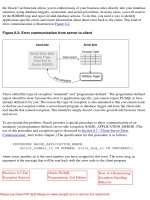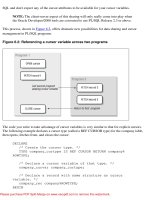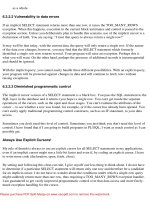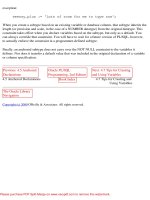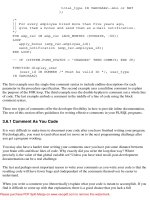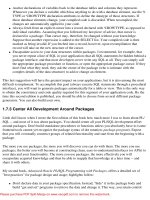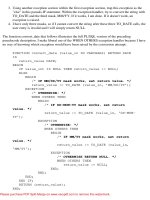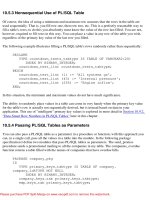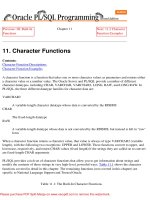OReilly oracle SQL tuning pocket reference nov 2001 ISBN 0596002688 pdf
Bạn đang xem bản rút gọn của tài liệu. Xem và tải ngay bản đầy đủ của tài liệu tại đây (981.09 KB, 90 trang )
Oracle SQL Tuning Pocket Reference
By Mark Gurry
Publisher : O'Reilly
Pub Date : January 2002
ISBN : 0-596-00268-8
•
Table
of
Pages : 108
Contents
• Index
• Reviews
•
Reader
Reviews
• Errata
Copyright
Chapter 1. Oracle SQL TuningPocket Reference
Section 1.1. Introduction
Section 1.2. The SQL Optimizers
Section 1.3. Rule-Based Optimizer Problems and Solutions
Section 1.4. Cost-Based Optimizer Problems and Solutions
Section 1.5. Problems Common to Rule and Cost with Solutions
Section 1.6. Handy SQL Tuning Tips
Section 1.7. Using SQL Hints
Section 1.8. Using DBMS_STATS to Manage Statistics
Section 1.9. Using Outlines for Consistent Execution Plans
Index
Chapter 1. Oracle SQL TuningPocket Reference
Section 1.1. Introduction
Section 1.2. The SQL Optimizers
Section 1.3. Rule-Based Optimizer Problems and Solutions
Section 1.4. Cost-Based Optimizer Problems and Solutions
Section 1.5. Problems Common to Rule and Cost with Solutions
Section 1.6. Handy SQL Tuning Tips
Section 1.7. Using SQL Hints
Section 1.8. Using DBMS_STATS to Manage Statistics
Section 1.9. Using Outlines for Consistent Execution Plans
1.1 Introduction
This book is a quick-reference guide for tuning Oracle SQL. This is not a comprehensive Oracle
tuning book.
The purpose of this book is to give you some light reading material on my "real world" tuning
experiences and those of my company, Mark Gurry & Associates. We tune many large Oracle sites.
Many of those sites, such as banks, large financial institutions, stock exchanges, and electricity
markets, are incredibly sensitive to poor performance.
With more and more emphasis being placed on 24/7 operation, the pressure to make SQL perform in
production becomes even more critical. When a new SQL statement is introduced, we have to be
absolutely sure that it is going to perform. When a new index is added, we have to be certain that it
will not be used inappropriately by existing SQL statements. This book addresses these issues.
Many sites are now utilizing third-party packages such as Peoplesoft, SAP, Oracle Applications,
Siebel, Keystone, and others. Tuning SQL for these applications must be done without placing hints
on SQL statements, because you are unauthorized to touch the application code. Obviously, for
similar reasons, you can't rewrite the SQL. But don't lose heart; there are many tips and tricks in this
reference that will assist you when tuning packaged software.
This book portrays the message, and my firm belief, that there is always a way of improving your
performance to make it acceptable to your users.
1.1.1 Acknowledgments
Many thanks to my editor, Jonathan Gennick. His feedback and suggestions have added significant
improvements and clarity to this book. A hearty thanks to my team of technical reviewers: Sanjay
Mishra, Stephen Andert, and Tim Gorman.Thanks also to my Mark Gurry & Associates consultants
for their technical feedback. Special thanks to my wife Juliana for tolerating me during yet another
book writing exercise.
1.1.2 Caveats
This book does not cover every type of environment, nor does it cover all performance tuning
scenarios that you will encounter as an Oracle DBA or developer.
I can't stress enough the importance of regular hands-on testing in preparation for being able to
implement your performance tuning recommendations.
1.1.3 Conventions
UPPERCASE
Indicates a SQL keyword
lowercase
Indicates user-defined items such as tablespace names and datafile names
Constant width
Used for examples showing code
Constant width bold
Used for emphasis in code examples
[]
Used in syntax descriptions to denote optional elements
{}
Used in syntax descriptions to denote a required choice
|
Used in syntax descriptions to separate choices
1.1.4 What's New in Oracle9i
It's always exciting to get a new release of Oracle. This section briefly lists the new Oracle9i features
that will assist us in getting SQL performance to improve even further than before. The new features
are as follows:
•
A new INIT.ORA parameter, FIRST_ROWS_n, that allows the cost-based optimizer to
make even better informed decisions on the optimal execution path for an OLTP application.
The n can equal 1, 10, 100, or 1,000. If you set the parameter to FIRST_ROWS_1, Oracle
will determine the optimum execution path to return one row; FIRST_ROWS_10 will be the
optimum plan to return ten rows; and so on.
•
There is a new option called SIMILAR for use with the CURSOR_SHARING parameter.
The advantages of sharing cursors include reduced memory usage, faster parses, and
reduced latch contention. SIMILAR changes literals to bind variables, and differs from the
FORCE option in that similar statements can share the same SQL area without resulting in
degraded execution plans.
•
There is a new hint called CURSOR_SHARING_EXACT that allows you to share cursors
for all statements except those with this hint. In essence, this hint turns off cursor sharing for
an individual statement.
•
There is a huge improvement in overcoming the skewness problem. The skewness problem
comes about because a bind variable is evaluated after the execution plan is decided. If you
have 1,000,000 rows with STATUS = `C' for Closed, and 100 rows with STATUS = `O' for
Open, Oracle should use the index on STATUS when you query for STATUS = `O', and
should perform a full table scan when you query for STATUS = `C'. If you used bind
variables prior to Oracle9i, Oracle would assume a 50/50 spread for both values, and would
use a full table scan in either case. Oracle 9i determines the value of the bind variable prior
to deciding on the execution plan. Problem solved!
•
You can nowidentify unused indexes using the ALTER INDEX MONITOR USAGE
command.
•
You can now use DBMS_STATS to gather SYSTEM statistics, including a system's CPU
and I/O usage. You may find that disks are a bottleneck, and Oracle will then have the
information to adjust the execution plans accordingly.
•
There are new hints, including NL_AJ, NL_SJ, FACT, NO_FACT, and FIRST_ROWS(n).
All are described in detail in Section 1.7 of this reference.
•
Outlines were introduced with Oracle8i to allow you to force execution plans (referred to as
"outlines") for selected SQL statements. However, it was sometimes tricky to force a SQL
statement to use a particular execution path. Oracle9i provides us with the ultimate: we can
now edit the outline using the DBMS_OUTLN_EDIT package.
1.2 The SQL Optimizers
Whenever you execute a SQL statement, a component of the database known as the optimizer must
decide how best to access the data operated on by that statement. Oracle supports two optimizers: the
rule-base optimizer (which was the original), and the cost-based optimizer.
To figure out the optimal execution path for a statement, the optimizers consider the following:
•
The syntax you've specified for the statement
•
Any conditions that the data must satisfy (the WHERE clauses)
•
The database tables your statement will need to access
•
All possible indexes that can be used in retrieving data from the table
•
The Oracle RDBMS version
•
The current optimizer mode
•
SQL statement hints
•
All available object statistics (generated via the ANALYZE command)
•
The physical table location (distributed SQL)
•
INIT.ORA settings (parallel query, async I/O, etc.)
Oracle gives you a choice of two optimizing alternatives: the predictable rule-based optimizer and
the more intelligent cost-based optimizer.
1.2.1 Understanding the Rule-Based Optimizer
The rule-based optimizer (RBO) uses a predefined set of precedence rules to figure out which path it
will use to access the database. The RDBMS kernel defaults to the rule-based optimizer under a
number of conditions, including:
•
OPTIMIZER_MODE = RULE is specified in your INIT.ORA file
•
OPTIMIZER_MODE = CHOOSE is specified in your INIT.ORA file, andno statistics exist
for any table involved in the statement
•
An ALTER SESSION SET OPTIMIZER_MODE = RULE command has been issued
•
An ALTER SESSION SET OPTIMIZER_MODE = CHOOSEcommand has been issued,
and no statistics exist for any table involved in the statement
•
The rule hint (e.g., SELECT /*+ RULE */. . .) has been used in the statement
The rule-based optimizer is driven primarily by 20 condition rankings, or "golden rules." These rules
instruct the optimizer how to determine the execution path for a statement, when to choose one index
over another, and when to perform a full table scan. These rules, shown in Table 1-1, are fixed,
predetermined, and, in contrast with the cost-based optimizer, not influenced by outside sources
(table volumes, index distributions, etc.).
Table 1-1. Rule-based optimizer condition rankings
Rank
Condition
1
ROWID = constant
2
Cluster join with unique or primary key = constant
3
Hash cluster key with unique or primary key = constant
4
Entire Unique concatenated index = constant
5
Unique indexed column = constant
6
Entire cluster key = corresponding cluster key of another table in the same cluster
7
Hash cluster key = constant
8
Entire cluster key = constant
9
Entire non-UNIQUE CONCATENATED index = constant
10
Non-UNIQUE index merge
11
Entire concatenated index = lower bound
12
Most leading column(s) of concatenated index = constant
13
14
Indexed column between low value and high value or indexed column LIKE "ABC%"
(bounded range)
Non-UNIQUE indexed column between low value and high value or indexed column like
`ABC%' (bounded range)
15
UNIQUE indexed column or constant (unbounded range)
16
Non-UNIQUE indexed column or constant (unbounded range)
17
Equality on non-indexed = column or constant (sort/merge join)
18
MAX or MIN of single indexed columns
19
ORDER BY entire index
20
Full table scans
While knowing the rules is helpful, they alone do not tell you enough about how to tune for the rulebased optimizer. To overcome this deficiency, the following sections provide some information that
the rules don't tell you.
1.2.1.1 What the RBO rules don't tell you #1
Only single column indexes are ever merged. Consider the following SQL and indexes:
SELECT col1, ...
FROM emp
WHERE emp_name = 'GURRY'
AND emp_no
= 127
AND dept_no = 12
Index1 (dept_no)
Index2 (emp_no, emp_name)
The SELECT statement looks at all three indexed columns. Many people believe that Oracle will
merge the two indexes, which involve those three columns, to return the requested data. In fact, only
the two-column index is used; the single-column index is not used. While Oracle will merge two
single-column indexes, it will not merge a multi-column index with another index.
There is one thing to be aware of with respect to this scenario. If the single-column index is a unique
or primary key index, that would cause the single-column index to take precedence over the multicolumn index. Compare rank 4 with rank 9 in Table 1-1.
Oracle8i introduced a new hint, INDEX_JOIN, that allows you to join
multi-column indexes.
1.2.1.2 What the RBO rules don't tell you #2
If all columns in an index are specified in the WHERE clause, that index will be used in preference
to other indexes for which some columns are referenced. For example:
SELECT col1, ...
FROM emp
WHERE emp_name = 'GURRY'
AND emp_no
= 127
AND dept_no = 12
Index1 (emp_name)
Index2 (emp_no, dept_no, cost_center)
In this example, only Index1 is used, because the WHERE clause includes all columns for that index,
but does not include all columns for Index2.
1.2.1.3 What the RBO rules don't tell you #3
If multiple indexes can be applied to a WHERE clause, and they all have an equal number of
columns specified, only the index created last will be used. For example:
SELECT col1, ...
FROM emp
WHERE emp_name = 'GURRY'
AND emp_no
= 127
AND dept_no = 12
AND emp_category = 'CLERK'
Index1 (emp_name, emp_category) Created 4pm Feb 11th 2002
Index2 (emp_no, dept_no) Created 5pm Feb 11th 2002
In this example, only Index2 is used, because it was created at 5 p.m. and the other index was
created at 4 p.m. This behavior can pose a problem, because if you rebuild indexes in a different
order than they were first created, a different index may suddenly be used for your queries. To deal
with this problem, many sites have a naming standard requiring that indexes are named in
alphabetical order as they are created. Then, if a table is rebuilt, the indexes can be rebuilt in
alphabetical order, preserving the correct creation order. You could, for example, number your
indexes. Each new index added to a table would then be given the next number.
1.2.1.4 What the RBO rules don't tell you #4
If multiple columns of an index are being accessed with an = operator, that will override other
operators such as LIKE or BETWEEN. Two ='s will override two ='s and a LIKE. For example:
SELECT col1, ...
FROM emp
WHERE emp_name LIKE 'GUR%'
AND emp_no
= 127
AND dept_no
= 12
AND emp_category = 'CLERK'
AND emp_class
= 'C1'
Index1 (emp_category, emp_class, emp_name)
Index2 (emp_no, dept_no)
In this example, only Index2 is utilized despite Index1 having three columns accessed and Index2
having only two column accessed.
1.2.1.5 What the RBO rules don't tell you #5
A higher percentage of columns accessed will override a lower percentage of columns accessed. So
generally, the optimizer will choose to use the index from which you specify the highest percentage
of columns. However, as stated previously, all columns specified in a unique or primary key index
will override the use of all other indexes. For example:
SELECT col1, ...
FROM emp
WHERE emp_name
= 'GURRY'
AND emp_no
= 127
AND emp_class
= 'C1'
Index1 (emp_name, emp_class, emp_category)
Index2 (emp_no, dept_no)
In this example, only Index1 is utilized, because 66% of the columns are accessed. Index2 is not
used because a lesser 50% of the indexed columns are used.
1.2.1.6 What the RBO rules don't tell you #6
If you join two tables, the rule-based optimizer needs to select a driving table. The table selected can
have a significant impact on performance, particularly when the optimizer decides to use nested
loops. A row will be returned from the driving table, and then the matching rows selected from the
other table. It is important that as few rows as possible are selected from the driving table.
The rule-based optimizer uses the following rules to select the driving table:
•
A unique or primary key index will always cause the associated table to be selected as the
driving table in front of a non-unique or non-primary key index.
•
An index for which you apply the equality operator (=) to all columns will take precedence
over indexes from which you use only some columns, and will result in the underlying table
being chosen as the driving table for the query.
•
The table that has a higher percentage of columns in an index will override the table that has
a lesser percentage of columns indexed.
•
A table that satisfies one two-column index in the WHERE clause of a query will be chosen
as the driving table in front of a table that satisfies two single-column indexes.
•
If two tables have the same number of index columns satisfied, the table that is listed last in
the FROM clause will be the driving table. In the SQL below, the EMP table will be the
driving table because it is listed last in the FROM clause.
•
•
•
•
SELECT ....
FROM DEPT d, EMP e
WHERE e.emp_name
= 'GURRY'
AND d.dept_name
= 'FINANCE'
AND d.dept_no
= e.dept_no
1.2.1.7 What the RBO rules don't tell you #7
If a WHERE clause has a column that is the leading column on any index, the rule-based optimizer
will use that index. The exception is if a function is placed on the leading index column in the
WHERE clause. For example:
SELECT col1, ...
FROM emp
WHERE emp_name
= 'GURRY'
Index1 (emp_name, emp_class, emp_category)
Index2 (emp_class, emp_name, emp_category)
Index1 will be used, because emp_name (used in the WHERE clause) is the leading column. Index2
will not be used, because emp_name is not the leading column.
The following example illustrates what happens when a function is applied to an indexed column:
SELECT col1, ...
FROM emp
WHERE LTRIM(emp_name) = 'GURRY'
In this case, because the LTRIM function has been applied to the column, no index will be used.
1.2.2 Understanding the Cost-Based Optimizer
The cost-based optimizer is a more sophisticated facility than the rule-based optimizer. To determine
the best execution path for a statement, it uses database information such as table size, number of
rows, key spread, and so forth, rather than rigid rules.
The information required by the cost-based optimizer is available once a table has been analyzed via
the ANALYZE command, or via the DBMS_STATS facility. If a table has not been analyzed, the
cost-based optimizer can use only rule-based logic to select the best access path. It is possible to run
a schema with a combination of cost-based and rule-based behavior by having some tables analyzed
and others not analyzed.
The ANALYZE command and the DBMS_STATS functions collect
statistics about tables, clusters, and indexes, and store those statistics in the
data dictionary.
A SQL statement will default to the cost-based optimizer if any one of the tables involved in the
statement has been analyzed. The cost-based optimizer then makes an educated guess as to the best
access path for the other tables based on information in the data dictionary.
The RDBMS kernel defaults to using the cost-based optimizer under a number of situations,
including the following:
•
OPTIMIZER_MODE = CHOOSE has been specified in the INIT.ORA file, and statistics
exist for at least one table involved in the statement
•
An ALTER SESSION SET OPTIMIZER_MODE = CHOOSE command has been executed,
and statistics exist for at least one table involved in the statement
•
An ALTER SESSION SET OPTIMIZER_MODE = FIRST_ROWS (or ALL_ROWS)
command has been executed, and statistics exist for at least one table involved in the
statement
•
A statement uses the FIRST_ROWS or ALL_ROWS hint (e.g., SELECT /*+
FIRST_ROWS */. . .)
1.2.2.1 ANALYZE command
The way that you analyze your tables can have a dramatic effect on your SQL performance. If your
DBA forgets to analyze tables or indexes after a table re-build, the impact on performance can be
devastating. If your DBA analyzes each weekend, a new threshold may be reached and Oracle may
change its execution plan. The new plan will more often than not be an improvement, but will
occasionally be worse.
I cannot stress enough that if every SQL statement has been tuned, do not analyze just for the sake of
it. One site that I tuned had a critical SQL statement that returned data in less than a second. The
DBA analyzed each weekend believing that the execution path would continue to improve. One
Monday, morning I got a phone call telling me that the response time had risen to 310 seconds.
If you do want to analyze frequently, use DBMS_STATS.EXPORT_SCHEMA_STATS to back up
the existing statistics prior to re-analyzing. This gives you the ability to revert back to the previous
statistics if things screw up.
When you analyze, you can have Oracle look at all rows in a table (ANALYZE COMPUTE) or at a
sampling of rows (ANALYZE ESTIMATE). Typically, I use ANALYZE ESTIMATE for very large
tables (1,000,000 rows or more), and ANALYZE COMPUTE for small to medium tables.
I strongly recommend that you analyze FOR ALL INDEXED COLUMNS for any table that can
have severe data skewness. For example, if a large percentage of rows in a table has the same value
in a given column, that represents skewness. The FOR ALL INDEXED COLUMNS option makes
the cost-based optimizer aware of the skewness of a column's data in addition to the cardinality
(number-distinct values) of that data.
When a table is analyzed using ANALYZE, all associated indexes are analyzed as well. If an index
is subsequently dropped and recreated, it must be re-analyzed. Be aware that the procedures
DBMS_STATS.GATHER_SCHEMA_STATS and GATHER_TABLE_STATS analyze only tables
by default, not their indexes. When using those procedures, you must specify the
CASCADE=>TRUE option for indexes to be analyzed as well.
Following are some sample ANALYZE statements:
ANALYZE TABLE EMP ESTIMATE STATISTICS SAMPLE 5 PERCENT FOR
ALL INDEXED COLUMNS;
ANALYZE INDEX EMP_NDX1 ESTIMATE STATISTICS SAMPLE 5 PERCENT
FOR ALL INDEXED COLUMNS;
ANALYZE TABLE EMP COMPUTE STATISTICS FOR ALL INDEXED COLUMNS;
If you analyze a table by mistake, you can delete the statistics. For example:
ANALYZE TABLE EMP DELETE STATISTICS;
Analyzing can take an excessive amount of time if you use the COMPUTE option on large objects.
We find that on almost every occasion, ANALYZE ESTIMATE 5 PERCENT on a large table forces
the optimizer make the same decision as ANALYZE COMPUTE.
1.2.2.2 Tuning prior to releasing to production
A major dilemma that exists with respect to the cost-based optimizer (CBO) is how to tune the SQL
for production prior to it being released. Most development and test databases will contain
substantially fewer rows than a production database. It is therefore highly likely that the CBO will
make different decisions on execution plans. Many sites can't afford the cost and inconvenience of
copying the production database into a pre-production database.
Oracle8i and later provides various features to overcome this problem, including DBMS_STATS
and the outline facility. Each is explained in more detail later in this book.
1.2.2.3 Inner workings of the cost-based optimizer
Unlike the rule-based optimizer, the cost-based optimizer does not have hard and fast path
evaluation rules. The cost-based optimizer is flexible and can adapt to its environment. This
adaptation is possible only once the necessary underlying object statistics have been refreshed (reanalyzed). What is constant is the method by which the cost-based optimizer calculates each possible
execution plan and evaluates its cost (efficiency).
The cost-based optimizer's functionality can be (loosely) broken into the following steps:
1. Parse the SQL (check syntax, object privileges, etc.).
2. Generate a list of all potential execution plans.
3. Calculate (estimate) the cost of each execution plan using all available object statistics.
4. Select the execution plan with thelowest cost.
The cost-based optimizer will be used only if at least one table within a SQL statement has statistics
(table statistics for unanalyzed tables are estimated). If no statistics are available for any table
involved in the SQL, the RDBMS will resort to the rule-based optimizer, unless the cost-based
optimizer is forced via statement-level HINTS or by an optimizer goal of ALL_ROWS or
FIRST_ROWS.
To understand how the cost-based optimizer works and, ultimately, how to exploit it, we need to
understand how it thinks.
Primary key and/or UNIQUE index equality
A UNIQUE index's selectivity is recognized as 100%. No other indexed access method is
more precise. For this reason, a unique index is always used when available.
Non-UNIQUE index equality
For non-UNIQUE indexes, index selectivity is calculated. The cost-based optimizer makes
the assumption that the table (and subsequent indexes) have uniform data spread unless you
use the FOR ALL INDEXED COLUMNS option of the ANALYZE. That option will make
the cost-based optimizer aware of how the data in the indexed columns is skewed.
Range evaluation
For index range execution plans, selectivity is evaluated. This evaluation is based on a
column's most recent high-value and low-value statistics. Again, the cost-based optimizer
makes the assumption that the table (and subsequent indexes) have uniform data spread
unless you use the FOR ALL INDEXED COLUMNS option when analyzing the table.
Range evaluation over bind variables
For index range execution plans, selectivity is guessed. Prior to Oracle9i, because bind
variable values are not available at parse time (values are passed to the cursor after the
execution plan has been decided), the optimizer cannot make decisions based on bind
variable values. The optimizer assumes a rule of thumb of 25% selectivity for unbounded
bind variable ranges (e.g., WHERE dept_no = :b1) and 50% selectivity for bounded ranges
(WHERE dept_no > :b1 AND dept_no < :b2). Beginning with Oracle9i, the cost-based
optimizer obtains bind variable values prior to determining an execution plan.
Histograms
Prior to the introduction of histograms in Oracle 7.3, The cost-based optimizer could not
distinguish grossly uneven key data spreads.
System resource usage
By default, the cost-based optimizer assumes that you are the only person accessing the
database. Oracle9i gives you the ability to store information about system resource usage,
and can make much better informed decisions based on workload (read up on the
DBMS_STATS.GATHER_SYSTEM_STATS package).
Current statistics are important
The cost-based optimizer can make poor execution plan choices when a table has been
analyzed but its indexes have not been, or when indexes have been analyzed but not the
tables.
You should not force the database to use the cost-based optimizer via inline hints when no
statistics are available for any table involved in the SQL.
Using old (obsolete) statistics can be more dangerous than estimating the statistics at
runtime, but keep in mind that changing statistics frequently can also blow up in your face,
particularly on a mission-critical system with lots of online users. Always back up your
statistics before you re-analyze by using DBMS_STATS.EXPORT_SCHEMA_STATS.
Analyzing large tables and their associated indexes with the COMPUTE option will take a
long, long time, requiring lots of CPU, I/O, and temporary tablespace resources. It is often
overkill. Analyzing with a consistent value, for example, estimate 3%, will usually allow the
cost-based optimizer to make optimal decisions
Combining the information provided by the selectivity rules with other database I/O information
allows the cost-based optimizer to calculate the cost of an execution plan.
1.2.2.4 EXPLAIN PLAN for the cost-based optimizer
Oracle provides information on the cost of query execution via the EXPLAIN PLAN facility.
EXPLAIN PLAN can be used to display the calculated execution cost(s) via some extensions to the
utility. In particular, the plan table's COST column returns a value that increases or decreases to
show the relative cost of a query. For example:
EXPLAIN PLAN FOR
SELECT count(*)
FROM winners, horses
WHERE winners.owner=horses.owner
AND winners.horse_name LIKE 'Mr %'
COLUMN "SQL" FORMAT a56
SELECT lpad(' ',2*level)||operation||''
||options ||' '||object_name||
decode(OBJECT_TYPE, '', '',
'('||object_type||')') "SQL",
cost "Cost", cardinality "Num Rows"
FROM
plan_table
CONNECT BY prior id = parent_id
START WITH id = 0;
SQL
Cost
Num Rows
----------------------------------------------SELECT STATEMENT
44
1
SORT AGGREGATE
HASH JOIN
44
100469
INDEX RANGE SCAN MG1(NON-UNIQUE)
2
1471
INDEX FAST FULL SCAN OWNER_PK(UNIQUE)
4
6830
By manipulating the cost-based optimizer (i.e., via inline hints, by creating/removing indexes, or by
adjusting the way that indexes or tables are analyzed), we can see the differences in the execution
cost as calculated by the optimizer. Use EXPLAIN PLAN to look at different variations on a query,
and choose the variation with the lowest relative cost.
For absolute optimal performance, many sites have the majority of the tables and indexes analyzed
but a small number of tables that are used in isolation are not analyzed. This is usually to force rulebased behavior on the tables that are not analyzed. However, it is important that tables that have not
been analyzed are not joined with tables that have been analyzed.
1.2.3 Some Common Optimizer Misconceptions
Let's clear up some common misconceptions regarding the optimizers:
Oracle8i and Oracle9i don't support the rule-based optimizer
This is totally false. Certain publications mentioned this some time ago, but Oracle now
assures us that this is definitely not true.
Hints can't be used with the rule-based optimizer
The large majority of hints can indeed be applied to SQL statements using the rule-based
optimizer.
SQL tuned for rule will run well in cost
If you are very lucky it may, but when you transfer to cost, expect a handful of SQL
statements that require tuning. However, there is not a single site that I have transferred and
been unable to tune.
SQL tuned for cost will run well in rule
This is highly unlikely, unless the code was written with knowledge of the rule-based
optimizer.
You can't run rule and cost together
You can run both together by setting the INIT.ORA parameter OPTIMIZER_MODE to
CHOOSE, and having some tables analyzed and others not. Be careful that you don't join
tables that are analyzed with tables that are not analyzed.
1.2.4 Which Optimizer to Use?
If you are currently using the rule-based optimizer, I strongly recommend that you transfer to the
cost-based optimizer. Here is a list of the reasons why:
•
The time spent coding is reduced.
•
Coders do not need to be aware of the rules.
•
There are more features, and far more tuning tools, available for the cost-based optimizer.
•
The chances of third-party packages performing well has been improved considerably.
Many third-party packages are written to run on DB2, Informix, and SQL*Server, as well as
on Oracle. The code has not been written to suit the rule-based optimizer; it has been written
in a generic fashion.
•
End users can develop tuned code without having to learn a large set of optimizer rules.
•
The cost-based optimizer has improved dramatically from one version of Oracle to the next.
Development of the rule-based optimizer is stalled.
•
There is less risk from adding new indexes.
•
There are many features that are available only with the cost-based optimizer. These
features include recognition of materialized views, star transformation, the use of function
indexes, and so on. The number of such features is huge, and as time goes on, the gap
between cost and rule will widen.
•
Oracle has introduced features such as the DBMS_STATS package and outlines to get
around known problems with the inconsistency of the cost-based optimizer across
environments.
1.3 Rule-Based Optimizer Problems and Solutions
The rule-based optimizer provides a good deal of scope for tuning. Because its behavior is
predictable, and governed by the 20 condition rankings presented earlier in Table 1-1, we are easily
able to manipulate its choices.
I have been tracking the types of problems that occur with both optimizers as well as the best way of
fixing the problems. The major causes of poor rule-based optimizer performance are shown in Table
1-2.
Table 1-2. Common rule-based optimizer problems
Problem
% Cases
1. Incorrect driving table
40%
2. Incorrect index
40%
3. Incorrect driving index
10%
4. Using the ORDER BY index and not the WHERE index
10%
Each problem, along with its solution, is explained in detail in the following sections.
1.3.1 Problem 1: Incorrect Driving Table
If the table driving a join is not optimal, there can be a significant increase in the amount of time
required to execute a query. Earlier, in Section 1.2.1.6, I discussed what decides the driving table.
Consider the following example, which illustrates the potential difference in runtimes:
SELECT COUNT(*)
FROM acct a, trans b
WHERE b.cost_center = 'MASS'
AND a.acct_name = 'MGA'
AND a.acct_name = b.acct_name;
In this example, if ACCT_NAME represents a unique key index and COST_CENTER represents a
single column non-unique index, the unique key index would make the ACCT table the driving table.
If both COST_CENTER and ACCT_NAME were single column, non-unique indexes, the rulebased optimizer would select the TRANS table as the driving table, because it is listed last in the
FROM clause. Having the TRANS table as the driving table would likely mean a longer response
time for a query, because there is usually only one ACCT row for a selected account name but there
are likely to be many transactions for a given cost center.
With the rule-based optimizer, if the index rankings are identical for both tables, Oracle simply
executes the statement in the order in which the tables are parsed. Because the parser processes table
names from right to left, the table name that is specified last (e.g., DEPT in the example above) is
actually the first table processed (the driving table).
SELECT COUNT(*)
FROM acct a, trans b
WHERE b.cost_center = 'MASS'
AND a.acct_name = 'MGA'
AND a.acct_name = b.acct_name;
Response = 19.722 seconds
The response time following the re-ordering of the tables in the FROM clause is as follows:
SELECT COUNT(*)
FROM trans b, acct a
WHERE b.cost_center= 'MASS'
AND a.acct_name = 'MGA'
AND a.acct_name = b.acct_name;
Response = 1.904 seconds
It is important that the table that is listed last in the FROM clause is going to return the fewest
number of rows. There is also potential to adjust your indexing to force the driving table. For
example, you may be able to make the COST_CENTER index a concatenated index, joined with
another column that is frequently used in SQL enquires with the column. This will avoid it ranking
so highly when joins take place.
1.3.2 Problem 2: Incorrect Index
WHERE clauses often provide the rule-based optimizer with a number of indexes that it could utilize.
The rule-based optimizer is totally unaware of how many rows each index will be required to scan
and the potential impact on the response time. A poor index selection will provide a response time
much greater than it would be if a more effective index was selected.
The rule-based optimizer has simple rules for selecting which index to use. These rules and scenarios
are described earlier in the various "What the RBO rules don't tell you" sections.
Let's consider an example.
An ERP package has been developed in a generic fashion to allow a site to use columns for reporting
purposes in any way its users please. There is a column called BUSINESS_UNIT that has a singlecolumn index on it. Most sites have hundreds of business units. Other sites have only one business
unit.
Our JOURNAL table has an index on (BUSINESS_UNIT), and another on (BUSINESS_UNIT,
ACCOUNT, JOURNAL_DATE). The WHERE clause of a query is as follows:
WHERE business_unit ='A203'
AND account
= 801919
AND journal_date between
'01-DEC-2001'
and '31-DEC-2001'
The single-column index will be used in preference to the three-column index, despite the fact that
the three-column index returns the result in a fraction of the time of the single-column index. This is
because all columns in the single-column index are used in the query. In such a situation, the only
options open to us are to drop the index or use the cost-based optimizer. If you're not using packaged
software, you may also be able to use hints.
1.3.3 Problem 3: Incorrect Driving Index
The way you specify conditions in the WHERE clause(s) of your SELECT statements has a major
impact on the performance of your SQL, because the order in which you specify conditions impacts
the indexes the optimizer choose to use.
If two index rankings are equal -- for example, two single-column indexes both have their columns
in the WHERE clause -- Oracle will merge the indexes. The merge (AND-EQUAL) order has the
potential to have a significant impact on runtime. If the index that drives the query returns more rows
than the other index, query performance will be suboptimal. The effect is very similar to that from
the ordering of tables in the FROM clause. Consider the following example:
SELECT COUNT(*)
FROM trans
WHERE cost_center = 'MASS'
AND bmark_id
= 9;
Response Time = 4.255 seconds
The index that has the column that is listed first in the WHERE CLAUSE will drive the query. In
this statement, the indexed entries for COST_CENTER = `MASS' will return significantly more
rows than those for BMARK_ID=9, which will return at most only one or two rows.
The following query reverses the order of the conditions in the WHERE clause, resulting in a much
faster execution time.
SELECT COUNT(*)
FROM trans
WHERE bmark_id
= 9
AND cost_center = 'MASS';
Response Time = 1.044 seconds
For the rule-based optimizer, you should order the conditions that are going to return the fewest
number of rows higher in your WHERE clause.
1.3.4 Problem 4: Using the ORDER BY Indexand not the WHERE
Index
A less common problem with index selection, which we have observed at sites using the rule-based
optimizer, is illustrated by the following query and indexes:
SELECT fod_flag, account_no...
FROM account_master
WHERE (account_code like 'I%')
ORDER BY account_no;
Index_1 UNIQUE (ACCOUNT_NO)
Index_2
(ACCOUNT_CODE)
With the indexes shown, the runtime of this query was 20 minutes. The query was used for a report,
which was run by many brokers each day.
In this example, the optimizer is trying to avoid a sort, and has opted for the index that contains the
column in the ORDER BY clause rather than for the index that has the column in the WHERE
clause.
The site that experienced this particular problem was a large stock brokerage. The SQL was run
frequently to produce account financial summaries.
This problem was repaired by creating a concatenated index on both columns:
# Added Index (ACCOUNT_CODE, ACCOUNT_NO)
We decided to drop index_2 (ACCOUNT CODE), which was no longer required because the
ACCOUNT_CODE was the leading column of the new index. The ACCOUNT_NO column was
added to the new index to take advantage of the index storing the data in ascending order. Having
the ACCOUNT_NO column in the index avoided the need to sort, adding the index in a runtime of
under 10 seconds.
1.4 Cost-Based Optimizer Problems and Solutions
The cost-based optimizer has been significantly improved from its initial inception. My
recommendation is that every site that is new to Oracle should be using the cost-based optimizer. I
also recommend that sites currently using the rule-based optimizer have a plan in place for migrating
to the cost-based optimizer. There are, however, some issues with the cost-based optimizer that you
should be aware of. Table 1-3 lists the most common problems I have observed, along with their
frequency of occurrence.
Table 1-3. Common cost-based optimizer problems
Problem
% Cases
1. The skewness problem
30%
2. Analyzing with wrong data
25%
3. Mixing the optimizers in joins
20%
4. Choosing an inferior index
20%
5. Joining too many tables
< 5%
6. Incorrect INIT.ORA parameter settings
< 5%
1.4.1 Problem 1: The Skewness Problem
Imagine that we are consulting at a site with a table TRANS that has a column called STATUS. The
column has two possible values: `O' for Open Transactions that have not been posted, and `C' for
closed transactions that have already been posted and that require no further action. There are over
one million rows that have a status of `C', but only 100 rows that have a status of `O' at any point in
time.
The site has the following SQL statement that runs many hundreds of times daily. The response time
is dismal, and we have been called in to "make it go faster."
SELECT acct_no, customer, product, trans_date, amt
FROM trans
WHERE status='O';
Response time = 16.308 seconds
In this example, taken from a real-life client of mine, the cost-based optimizer decides that Oracle
should perform a full table scan. This is because the cost-based optimizer is aware of how many
distinct values there are for the status column, but is unaware of how many rows exist for each of
those values. Consequently, the optimizer assumes a 50/50 spread of data for each of the two values,
`O' and `C'. Given this assumption, Oracle has decided to perform a full table scan to retrieve open
transactions.
If we inform Oracle of the data skewness by specifying the option FOR ALL INDEXED
COLUMNS when we run the ANALYZE command or when we invoke the DBMS_STATS package,
Oracle will be made aware of the skewness of the data; that is, the number of rows that exist for each
value for each indexed column. In our scenario, the STATUS column is indexed. The following
command is used to analyze the table:
ANALYZE TABLE TRANS COMPUTE STATISTICS
FOR ALL INDEXED COLUMNS
After analyzing the table and computing statistics for all indexed columns, the cost-based optimizer
is aware that there are only 100 or so rows with a status of `O', and it will accordingly use the index
on that column. Use of the index on the STATUS column results in the following, much faster,
query response:
Response Time: 0.259 seconds
Typically the cost-based optimizer will perform a full table scan if the value selected for a column
has over 12% of the rows in the table, and will use the index if the value specified has less than 12%
of the rows. The cost-based optimizer selections are not quite as firm as this, but as a rule of thumb
this is the typical behavior that the cost-based optimizer will follow.
Prior to Oracle9i, if a statement has been written to use bind variables, problems can still occur with
respect to skewness even if you use FOR ALL INDEXED COLUMNS. Consider the following
example:
local_status := 'O';
SELECT acct_no, customer, product, trans_date, amt
FROM trans
WHERE status= local_status;
# Response time = 16.608
Notice that the response time is similar to that experienced when the FOR ALL INDEXED columns
option was not used. The problem here is that the cost-based optimizer isn't aware of the value of the
bind variable when it generates an execution plan. As a general rule, to overcome the skewness
problem, you should do the following:
•
Hardcode literals if possible. For example, use WHERE STATUS = `O', not WHERE
STATUS = local_status.
•
Always analyze with the option FOR ALL INDEXED COLUMNS.
If you are still experiencing performance problems in which the cost-based optimizer will not use an
index due to bind variables being used, and you can't change the source code, you can try deleting
the statistics off the index using a command such as the following:
ANALYZE INDEX
TRANS_STATUS_NDX
DELETE STATISTICS
Deleting the index statistics works because it forces rule-based optimizer behavior, which will
always use the existing indexes (as opposed to doing full table scans).
Oracle9i will evaluate the bind variable value prior to deciding the execution
plan, obviating the need to hardcode literal values.
1.4.2 Problem 2: Analyzing with Wrong Data
I have been invited to many, many sites that have performance problems at which I quickly
determined that the tables and indexes were not analyzed at a time when they contained typical
volumes of data. The cost-based optimizer requires accurate information, including accurate data
volumes, to have any chance of creating efficient execution plans.
The times when the statistics are most likely to be forgotten or out of date are when a table is rebuilt
or moved, an index is added, or a new environment is created. For example, a DBA might forget to
regenerate statistics after migrating a database schema to a production environment. Other problems
typically occur when the DBA does not have a solid knowledge of the database that he/she is dealing
with and analyzes a table when it has zero rows, instead of when it has hundreds of thousands of
rows shortly afterwards.
1.4.2.1 How to check the last analyzed date
To observe which tables, indexes, and partitions have been analyzed, and when they were last
analyzed, you can select the LAST_ANALYZED column from the various user_XXX view. For
example, to determine the last analyzed date for all your tables:
SELECT table_name, num_rows,
last_analyzed
FROM user_tables;
In addition to user_tables, there are many other views you can select to view the date an object was
last analyzed. To obtain a full list of views with LAST_ANALYZED dates, run the following query:
